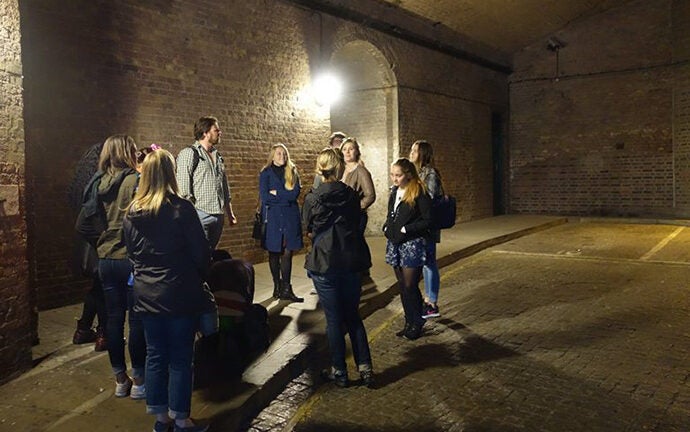
Students explore the history of masculine and feminine roles in London
Darkness fell and a chill descended over the cobbled streets of London’s East End as the group of 10 USC Dornsife undergraduates retraced the last steps of the female victims of notorious serial killer Jack the Ripper.
Led by Lindsay O’Neill, assistant professor (teaching) of history, the cohort had travelled to the British capital for a seven-day stay as the culmination of her course “Sex and the City, Constructing Gender in London, 1700 to 1900.”
Earlier in the day, the students had explored the elegant and luxurious Victoria and Albert Museum (V&A), the world’s largest museum of decorative arts and design. Now they were plunged into a very different environment.
“Walking through these streets as the sun set invoked a much colder, grimmer world,” O’Neill said.
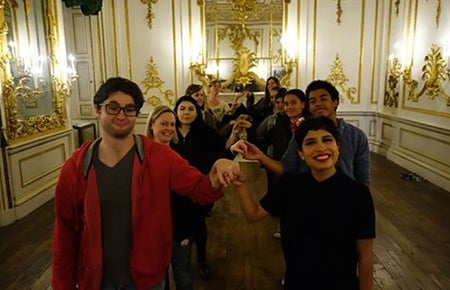
At the Victoria and Albert Museum, students recreate a period dance in the Norfolk House Music Room.
At the V&A, they had visited the Norfolk House Music Room, a space that, with its deep yellow walls lined with elaborate mirrors, O’Neill compared to a jewel box.
“Being able to experience this sumptuous room really brought home the rich existence of the elite men and women who inhabited these spaces,” she said.
Now, however, the students were acquiring a disquieting sense of the poverty-stricken Victorian underclass inhabited by Jack the Ripper’s victims. The experience allowed the students to see how the lower classes lived — far from those jewel-box spaces that constrained elite women but also protected them from much of the harm and struggle faced by working-class women living on society’s margins.
“Reading news coverage of Jack the Ripper … is interesting and useful, but feeling the chills on your neck as you walk through Spitalfields and Whitechapel brings something to the course that can’t be found in the classroom,” history major Jordan Mulevicz wrote in an essay for the course blog.
Space matters
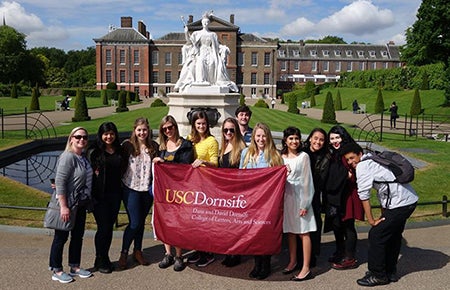
USC Dornsife history majors visit Kensington Palace.
O’Neill noted that 18th- and 19th-century London is a rich source of inspiration for gender studies. As the British capital experienced unprecedented growth, its burgeoning suburbs meant men were increasingly moving outside the home as they traveled into the city to work.
“This transformed expectations for each gender, influencing people’s family lives, work experiences, and sense of self,” she said.
As the students learned how public and private spaces structure gender expectations, they visited the Charles Dickens Museum, where O’Neill asked them to choose the persona of someone familiar with the house — Dickens, his wife, a visitor or a servant. They then took interior photographs showing that individual’s personal experience of the space.
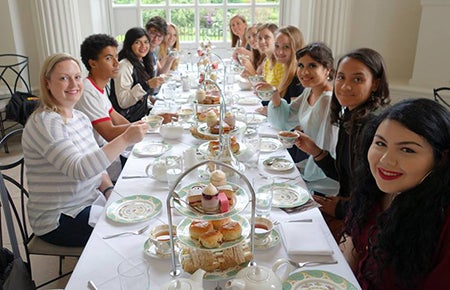
Tasting the delights of afternoon tea at the Orangery.
Exploring places that were the purview of the female sex, the group visited London department stores and took afternoon tea at the Orangery. To gain an understanding of typically male settings, they toured Eton College, the elite boys’ boarding school, and lunched at Simpson’s Tavern, an 18th-century chop house that remains a bastion of masculinity.
Evolving fashion
The students also explored how changing fashions expressed and defined gender expectations. At USC, they had studied the V&A’s online database to explore how fashion evolved, from the freer styles of the Regency Period to more restricted Victorian clothes, with their boned corsets and fuller skirts. In London, they visited the V&A’s clothing collection to witness first-hand how the corset both reflects and symbolizes the more confined place occupied by women in 19th-century society.
“We saw the push towards a more somber, less fashion-oriented form of masculinity, and a more ornamental and restrictive form of femininity,” O’Neill said.
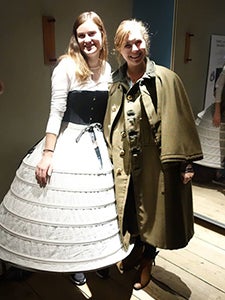
Experiencing gender construction firsthand by trying on Victorian fashions.
Takeaway
For their final project, students created an online exhibition using photographs taken during their trip. They also curated exhibits using primary sources from Special Collections at USC Libraries that were then displayed at USC’s Doheny Memorial Library.
O’Neill said she hopes the course helps students understand that objects, places, food and clothing can tell us as much about the historical past as scholarly documents.
“Ideas are anchored by things we eat, by things we wear, by places we live,” she said. “Understanding this is important to how we study history, but it’s also important to how we think about and evaluate the world around us today — that what we put on, what we eat, also has a story.”